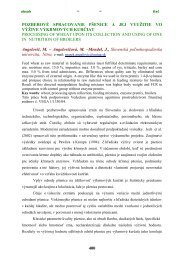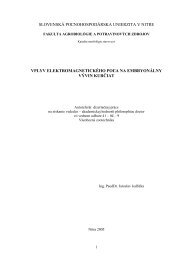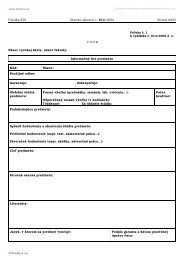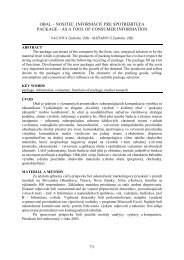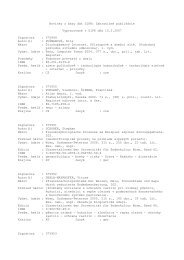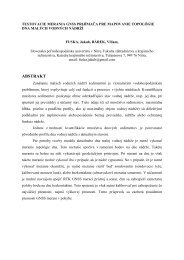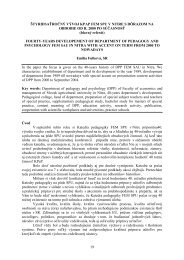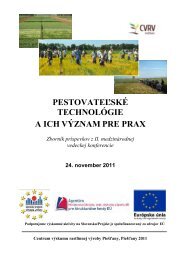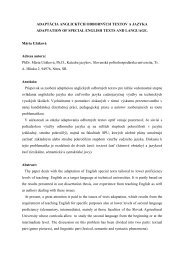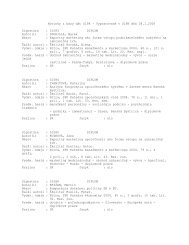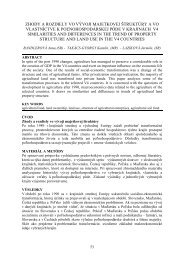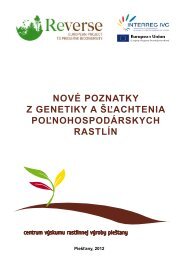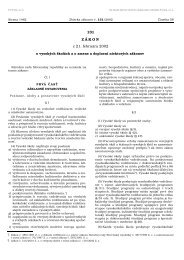Acta fytotechnica et zootechnica, Vol. 4, 2001, Special Number ...
Acta fytotechnica et zootechnica, Vol. 4, 2001, Special Number ...
Acta fytotechnica et zootechnica, Vol. 4, 2001, Special Number ...
You also want an ePaper? Increase the reach of your titles
YUMPU automatically turns print PDFs into web optimized ePapers that Google loves.
<strong>Acta</strong> <strong>fytotechnica</strong> <strong>et</strong> <strong>zootechnica</strong>, <strong>Vol</strong>. 4, <strong>2001</strong>, <strong>Special</strong> <strong>Number</strong><br />
Proceedings of the International Scientific Conference on the Occasion of the 55 th Anniversary of the Slovak Agricultural<br />
University in Nitra<br />
During three observed years, the weather conditions was very different, mainly in the viewpoint of precipitation and its<br />
distribution. In spite of it, the dynamics of soil humidity reached very equable course. Results explicitly confirmed, that<br />
b<strong>et</strong>ween two d<strong>et</strong>ermined soil cultivation variances (1. ploughing to the depth of 0.3 m with following of surface arrangement<br />
of ploughed field, 2. loosening of soil with combinatory) were not significant differences of water content in the soil. High<br />
significant differences of water content in the soil during the years were influenced by different sampling of the soil samples.<br />
Significant influence of d<strong>et</strong>ermined soil cultivation to the changes of soil humidity was not founded. Similarly Blevins <strong>et</strong> al.<br />
(1971) and Talafantová (1978) reported, that the content of water in non-cultivation soil is not significantly different with<br />
comparison of arable land.<br />
Significant differences in content of soil water were d<strong>et</strong>ermined within years, only. The soil humidity was increased with the<br />
soil depth. In 1996, we founded almost equal soil humidity in soil layers. Gnatenko (1992), Ver<strong>et</strong>eľnikov <strong>et</strong> al. (1992) founded<br />
higher content of soil water until to depth of 1.0-1.5 m, almost in dry conditions in favour of loosening against ploughing.<br />
References<br />
Table 1: Soil humidity in maize stand (cultivated after winter wheat) during 1995-1997 in depth of the soil 0.0-0.6 m<br />
Cultivation Date Average<br />
1995 3. 4. 10. 5. 21. 6. 13. 7. 22. 8. -<br />
B1 21.86 19.69 21.73 13.95 8.38 17.12<br />
B3 22.12 20.71 22.11 11.67 8.04 16.93<br />
1996 25. 3. 29. 4. 3. 6. 11. 7. 26. 8. -<br />
B1 22.42 17.10 23.97 17.57 13.94 19.00<br />
B3 22.20 16.80 22.73 19.70 14.55 19.20<br />
1997 11. 4. 7. 5. 2. 6. 16. 7. 20. 8. -<br />
B1 19.67 18.74 16.88 20.56 15.12 18.19<br />
B3 19.42 18.77 16.69 19.45 14.80 17.83<br />
Legend: B1: ploughing to the depth 0.3 m with following surface arrangement of ploughed field; B3: loosening of soil<br />
with combinatory.<br />
Blevins, R. L. <strong>et</strong> al. 1971. Influence of no-tillage on soil moisture. Agronomy Journal, 1971, 63, p. 593-596.<br />
Gnatenko, A. F. 1992. Ploskorez protiv erozii počvy. In: Zernovyje kuľtury. Moskva: „Kolos“, 1992, 2-3, p. 17-19.<br />
Hanes, J. - Mucha, V. - Slovík, R. - Zaujec, A. - Libant, V. 1991. Param<strong>et</strong>re východiskového stavu úrodnosti hnedozeme na<br />
stacionárnom pokuse výskumného projektu. In: Zborník „Ekologické princípy hospodárenia na vybraných agroekosystémoch<br />
južného Slovenska“. Nitra: VŠP, 1991, p. 21-24.<br />
Talafantová, A. 1978. Ovlivňovaní některých faktorů půdní úrodnosti obdelávaním půdy k obilovinám. In: Zborník „Obrábanie<br />
pôdy k obilninám“. Nitra: VŠP, 1978, p. 43-55.<br />
Ver<strong>et</strong>eľnikov, V. P. - Rjadovoj, V. A. - Radčenko, N. S. 1992. Vlijanije system podgotovki počvy na urožajnosť ozimoj<br />
pšenicej i jeji kačestvo posle gorocha. In: Zernovyje kuľtury. 1992, 4, p. 23-24.<br />
This work has been arisen by support of grant VEGA no. 1/8159/01.<br />
WINTER BARLEY GRAIN PRODUCTION IN DEPENDENCE ON SOME SAVING GROWING TECHNOLOGIES DURING<br />
TWO CLIMATIC DIFFERENT YEARS<br />
Summary<br />
Juliana MOLNÁROVÁ, Jozef ŽEMBERY, Rastislav BUŠO<br />
Department of Plant Production, Slovak Agricultural University, Tr. Andreja Hlinku 2, 949 76 Nitra<br />
We have examined the influence of different soil cultivation ways, vari<strong>et</strong>ies and year on the grain yield amount of winter<br />
barley in field polyfactor experiments in 1998/1999 and 1999/2000. There were four vari<strong>et</strong>ies (Luxor – multi-rowed, Babylone,<br />
Hanna, Tiffany – two-rowed vari<strong>et</strong>y) and three different tillage types (A-ploughing + post-harvest remainders, B-ploughing<br />
without remainders, C-discs without remainders). Results shown that there had been a statistically manifested difference<br />
b<strong>et</strong>ween the crop of two and multi-row barley in favour of Luxor vari<strong>et</strong>y (0,48 to 1,02 t.ha -1 ). The years crop influence has<br />
also been statistically manifested by the difference from 0,44 t.ha -1 (Luxor) to 1,14 t.ha -1 (Babylone). Results have shown that<br />
there had been a different reaction of vari<strong>et</strong>ies to tillage. Luxor, Hanna and Tiffany vari<strong>et</strong>y had reacted to the shallow soil<br />
23



